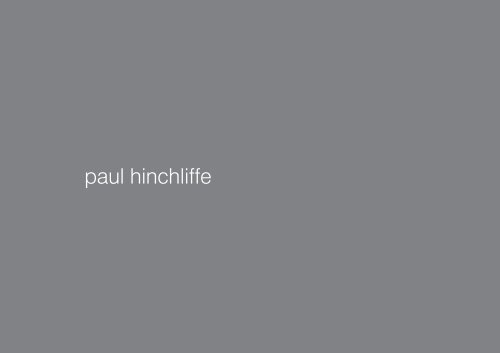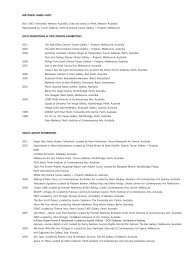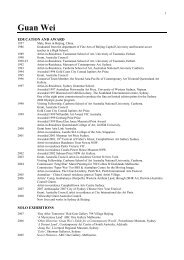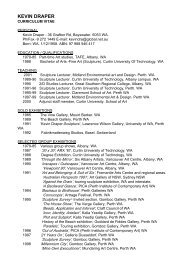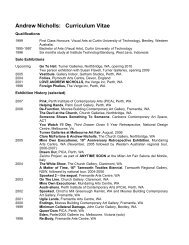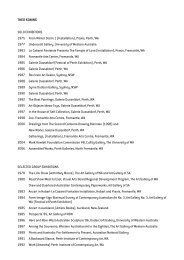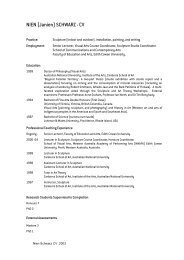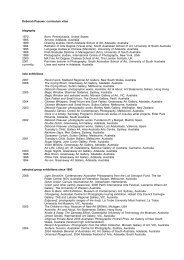to catch a herring catalogue - Turner Galleries
to catch a herring catalogue - Turner Galleries
to catch a herring catalogue - Turner Galleries
You also want an ePaper? Increase the reach of your titles
YUMPU automatically turns print PDFs into web optimized ePapers that Google loves.
paul hinchliffe
paul hinchliffe...<strong>to</strong> <strong>catch</strong> a <strong>herring</strong>
and then what? (and then what?)2A few years ago Paul Hinchliffe and I sat in a Leederville coffee shop talkingabout the weather. It was raining. We were clear about that. Which was good,because I was far from clear about a definition of Paul’s “art practice”. That’swhat we were really there <strong>to</strong> discuss, for a newspaper article I was trying <strong>to</strong>write. Paul <strong>to</strong>ld me he’d made sculptures on the beach at Quinns Rock. Thathe left them there. Didn’t even take pho<strong>to</strong>s. Maybe people stumbled uponthem. Maybe they were puzzled. Maybe they weren’t. He <strong>to</strong>ld me how he satdown with an international atlas, found a street name and sent a packageoff <strong>to</strong> an unknown addressee. It was a gift. He talked about the Heimatlos(homeless) project. Performances in carparks. Subterfuge in art galleries.Conceptualism and hobo-ism uniting. Just like Jack Kerouac and RichardLong said it would.We shook hands and I ran <strong>to</strong> my car. I got soaked <strong>to</strong> the skin. I shivered, wen<strong>to</strong>ver my notes in the office. The rain got harder as I typed them out, drowningout my keyboard plucking. My edi<strong>to</strong>r didn’t like the result. There was no hook.He’d as soon can the s<strong>to</strong>ry, if I didn’t mind. And I didn’t. Not really. For me,the interview was just another chance <strong>to</strong> piece <strong>to</strong>gether a puzzle I’d beentrying <strong>to</strong> figure out for a decade or so, since experiencing Paul as a lecturerat art school.Okay, critique is the wrong word. U<strong>to</strong>pia doesn’t await. Desire rules that out.Like Ramsay Street, art is a cul de sac <strong>to</strong> which we return again and againsearching for something, finding that content, context, perception, and plainold longing are bound in<strong>to</strong> the one infuriatingly dumb object - a thing on thewall. Or Harold Bishop.So, sure, Paul is putting things on the wall these days. And then what?We can puzzle them out, but will they have s<strong>to</strong>pped functioning, will we becomplete when we’re done sleuthing? This mirrors Yeats queries in his poem“What Then?”:‘The work is done’, grown old he thought,‘According <strong>to</strong> my boyish plan;Let the fools rage, I swerved in naught,Something <strong>to</strong> perfection brought’;But louder sang the ghost, “What then?” [2]Despite our best intentions, nothing will be resolved. The work, (all work),remains fugitive, a series of offerings, openings and refusals, doors slammedin the face, heads turned abruptly.To me, dopey and callow <strong>to</strong> the marrow, Paul was the unexpected incarnate.I’d arrived there, you know, just wanting <strong>to</strong> make stuff. Paul never made stuff.Or the stuff he made was more like anti-stuff - blank books, verbal imagesof Pythagorean formulae. Paul was the guy we first heard about Lacan andDerrida from. But, unlike so many of us who later delighted in what riot grrrlband Le Tigre call Fake French [1], he wasn’t name-dropping. And he wasn’t“applying theory” either. He was inside it, tied up and twisted. To be honest,it was kinda painful <strong>to</strong> see. Yet, from remote Lacanian lacunae he made usask ourselves what we were looking <strong>to</strong> art school for. He made us realise thatart is fundamentally about the transference. Art is about the questions weask of it, the responses we want back from it. So, when identity politics wereall the rage, when lines were being drawn in the sand, Paul was on<strong>to</strong>logicalman. Yes, it was unsettling. He frustrated us enough <strong>to</strong> make us think forourselves.At the same time he teased us. Thinking for ourselves, properly, was adiscursive impossibility. With Paul there were no platitudes <strong>to</strong> settle upon.So you’ll forgive me if I admit I’m suspicious of his new work. Work in a galleryno less. Work that seems sumptuous, even. I don’t trust my reaction, mypleasure. Mostly I don’t trust him. I’ve been burnt enough times <strong>to</strong> knowthat any claim <strong>to</strong> sensory pleasure is deeply rooted in a critique of suchphenomena.Like Lacan, Paul refuses <strong>to</strong> play the good daddy, <strong>to</strong> be our friend, <strong>to</strong> console.I find no comfort in this.And yet, I’m invigorated. Though I want the work <strong>to</strong> love me back, <strong>to</strong> let melove it, there’s something tragically beautiful about the dilemma. The new work<strong>to</strong>ys with this, makes us think it will, maybe, in the future, when the time is rightand the moon is high. It’s something old Gatsby would understand, and myguess is Paul and Jay would have been soul mates, knowing that everythingis out of reach, even themselves, even as they dream it otherwise.This <strong>to</strong>o is a projection. Narrative, poetry, all that. Another self-madeconsolation.It’s annoying. Paul reminds me how much I need these things, how weak I am.Again, I find no comfort in this. And can find no graceful way <strong>to</strong> exit this text.There is always another “what then?”And maybe I still don’t really get it anyway.It’s raining <strong>to</strong>day. Did I mention that?Robert CookNotes[1] Le Tigre. (2001). “Fake French”, on Feminist Sweepstakes,Tilt Records: Sydney. They sing: “I’ve got - the new sincerity.I’ve got - a secret vocabulary. I’ve got - dialectical sprecstime.I’ve got - a conceptual stunt double. I’ve got - site specificity.I’ve got - flow disruption. I’ve got - wildlife metaphors. I’ve got- post-binary gender chores....My Fake French is hot. You can’tmake me s<strong>to</strong>p”.[2] W.B. Yeats. “What Then?”, in Seamus Heaney, (2002).Finder’s Keepers: selected prose, 1971-2001. faber and faber:London. p.109.
hinchliffe’s paradoxesnotes <strong>to</strong>wards a speculative his<strong>to</strong>ry of the reversed canvasLets start with Blue Paper (p.9) first of the grey series. Like all these works, i<strong>to</strong>scillates between a series of flat canvases, two of them back-<strong>to</strong>-front on thisoccasion, and an illusion of a simple, 3D shape: in this case an empty boxwith its lid held mysteriously open on a plane exactly parallel with the <strong>to</strong>pmostplane of the opening whose interior it exposes. Like every other work in thisshow, the illusion is both punctured and sustained by the reversed canvas orcanvases: here a pair of triangular stretchers forming the apex of the irregularfive-sided plane, shaded in three <strong>to</strong>nes of grey, each a separate canvas - oneof Hinchliffe’s perplexing rules. The reversed canvases puncture the illusionby exposing part of its inner structure. But that inner structure also sustainsthe illusion because the braces correspond <strong>to</strong> the inner edges and side of thebox if it were a box and not a series of flat canvases thus revealed. The flat andsolid geometry flip in<strong>to</strong> each other very starkly in this example. Illusionisticallythere is no greater space depicted in the work than between the right-handedge of the brightly illuminated lid and the bot<strong>to</strong>m of the darkly shadowedleft-hand side of the box, but because the brightly illuminated lid seems <strong>to</strong>be the same diamond shape as the right-hand side of the box (whose shadeis between the other two), this serves <strong>to</strong> flatten the illusion, yet the differencein shade puts them at 90 degrees <strong>to</strong> each other, which reinforces the illusionagain. The artist observes that it would have been perfectly possible for him<strong>to</strong> paint the illusion of the inside of the box that the two reversed canvaseswith all their signs of workmanship constitute so imperfectly, but this wouldnot have been <strong>to</strong> ‘<strong>catch</strong> the <strong>herring</strong>’ in the same way or <strong>to</strong> the same degree.The audacity of showing the artifice behind the illusion seems <strong>to</strong> expose anexchange or slippage between two worlds of meaning that reinforce or canceleach other out <strong>to</strong> different degrees in different works. What are these worldsand what are their relations with each other?I doubt if I will provide an adequate answer, but the preoccupation with theartifice behind the illusion as part of the illusion has a long and distinguishedhis<strong>to</strong>ry that may at least deepen the question, if only by a process ofelimination. I shall structure this essay by moving from a work in the presentexhibition <strong>to</strong> some argument about past paintings that depict reversedcanvases, then back <strong>to</strong> another work by Paul, flip-flopping in and out of timelike Paul’s works do in space.On the face of it, I cannot think of a greater distance in worlds from Hinchliffe’sgeometrical traps and trips than Henry James’ literary dramatization of humanfronts and backs in The Europeans (1878), set in the sternly Protestantatmosphere of nineteenth-century New England. As the church bell <strong>to</strong>lls itsSunday summons, Gertrude is joined by her sternly reproachful elder sister,Charlotte, who is oddly attired in ‘a long red India scarf, which, on the front ofher dress, reached <strong>to</strong> her feet.’ An equally odd conversation ensues aboutthis. Charlotte feels uncomfortable that so much of her scarf hangs down atthe front, and Gertrude tastefully loosens and rearranges it so that it should‘look differently behind.’ Charlotte is alarmed by the implications of thissar<strong>to</strong>rial makeover and sharply corrects it by observing that‘Indeed, I don’t think it matters. … how one looks behind.’‘I should say it mattered more,’ said Gertrude.‘Then you don’t know who may be observing you. You are no<strong>to</strong>n your guard. You can’t try <strong>to</strong> look pretty.’Charlotte received this declaration with extreme gravity. ‘I don’tthink one should ever try <strong>to</strong> look pretty,’ she rejoined earnestly.Amusing in itself, this passage reveals a series of exquisitely ridiculoussubstitutions when read in the context of debates of the time about theconflicting claims of aestheticism (art for art’s sake) and the morality of art.The chief representative of the moral camp in England was the great Vic<strong>to</strong>riansage and uomo universalis John Ruskin, who in the 1850s described himselfmounting a sacristan’s ladder in the Venetian Church of San Giovanni ePaolo <strong>to</strong> observe the effigy of the recumbent Doge Andrea Vendramin bythe Renaissance sculp<strong>to</strong>r Tullio Lombardo. On reaching the <strong>to</strong>p of the ladderhe is seized with indignation. ‘At first I thought it had been broken off, but onclearing away the dust, I saw the wretched effigy had only one hand, andwas a mere block on the inner side. The face, heavy and disagreeable in itsfeatures, is made monstrous by its semi-sculpture... it having been supposedthroughout the work that the effigy was only <strong>to</strong> be seen from below, and fromone side.’ Ruskin’s verdict on the heartless expediency of the Italian sculp<strong>to</strong>rof this Catholic <strong>to</strong>mb opened an important chapter in the his<strong>to</strong>ry of Britishtaste, for as a consequence vigorous Anglican divines flocked <strong>to</strong> Italy <strong>to</strong>derive the ‘idolatry’ and Mariolatry’ <strong>to</strong> be found in the churches, <strong>to</strong> makesure that sculp<strong>to</strong>rs had not neglected their duty by completing only thoseparts of their work that were visible <strong>to</strong> the public.’ By transforming the issue ofthe sculp<strong>to</strong>r’s moral duty <strong>to</strong> complete the invisible flank of the dead Doge’srecumbent effigy in<strong>to</strong> the rather different issue of whether a young womanvery much alive should draw attention <strong>to</strong> her posterior in church by the wayher scarf was hanging introduces a wonderfully absurd sexual fac<strong>to</strong>r in<strong>to</strong> what<strong>to</strong>day might seem an equally absurd question of aesthetic morality, though italso introduces an aesthetic question in<strong>to</strong> a novelistic interlude, a slice of life.The only value of such a comparison might be <strong>to</strong> illustrate how utterly remoteHinchliffe’s preoccupations are from the living or the literary, for there isnothing circumstantial about the pure cube of Blue Paper except the humansigns of labour on the reversed canvas. But if we turn from this work <strong>to</strong> TheLast Leaf (p.15), then perhaps a spectrum opens up in this respect. If thebox with the lid was in the league of a Pla<strong>to</strong>nic form, Paul points out that TheLast Leaf, an empty rectangular pillar hinged in the middle and opened outat ninety degrees, is of human scale. He jokingly called it a lady cut in half,alluding <strong>to</strong> the magic trick which depends on a flash of sexual tension as
4much as theatrical deception for its effect. Yet if there is a tension betweenthose geometrically Pla<strong>to</strong>nic and the humanly desirable forms, its humour isdeepened by remoteness, the distance of the workshop from the bedroom.The titles put a similar distance between their meaning and what the workslook like.From The Last Leaf lets plunge a little deeper in<strong>to</strong> his<strong>to</strong>ry by considering theseissues from the angle of the impulse <strong>to</strong> show the back, as well as the front,of a canvas. One theory might be that <strong>to</strong> show the back of the canvas onthe front of the work of art projects an idea of <strong>to</strong>tal visibility in which the entirerealm of the visual comes within the artist’s reach, a form of <strong>to</strong>tal possession,<strong>to</strong>tal mastery, in whatever sense. Such an impulse might serve powerfulpropaganda needs when the patron enters the picture. Take what is perhapsthe most famous example of representation of the back of the canvas on thefront of the painting, Velazquez’s Las Meninas. So much ink has been spil<strong>to</strong>n so many interpretations of this painting that one trembles at the hubris ofattempting another, but, as far as the canvas is concerned, can one not saysome simple things that have not been said before? The artist stands proudlyin front of his canvas eyeing up his subjects on our side of the picture surface.Some say that we see that subject, the royal couple, reflected in a mirror atthe back of the hall. Measuring angles, however, mathematical scholars havetraced the image in the mirror <strong>to</strong> the image on Velazquez’s canvas in thepainting, whose surface we cannot see, except in the mirror. What we seeinstead is the whole drafty right-hand side of the back of the canvas, from ourpoint of view. Of course this isn’t the whole of the back of the canvas, but itpromises a fullness that the front of the real canvas, the one that still exists,seems <strong>to</strong> give us. For not only do we see the back of the canvas, we see thehandmaidens waiting on the royal Infanta, her dog, a court dwarf and otherofficials, including one who pauses with his foot on the doorway <strong>to</strong> the furtherworld beyond. From the point of view of court propaganda we are beingshown the loving and affectionate family circumstances within which the stiffroyal portrait is created. The back of the painting is a pledge of the love thatis passed off as the natural setting behind the monarchs’ public image. Whoknows whether this was true or not? It is what the raw back of the canvasleads us <strong>to</strong> suppose. But perhaps there’s more. From our point of view theartist is in front of his depicted canvas and we are behind it, but from hispoint of view is he not in some sense behind the real canvas that we see? Topaint it he must have been. One scholar has suggested that in this respectVelazquez might have been alluding <strong>to</strong> an ancient tradition about the backsof canvases. As Alberti, the Renaissance architect and theorist, reminded hisreader: ‘They say that Apelles hid behind a painting so that he could hear theirhonest opinions. Thus he heard how each one blamed or praised his work.Hence, I wish our painter openly <strong>to</strong> demand <strong>to</strong> hear each one who judgeshim. To the painter, all his merits were always known, and the things which hehas painted well are testimonies <strong>to</strong> his fame.’Velazquez was very proud of this painting for he painted an emblem of hisrise <strong>to</strong> higher rank as a red cross on his chest after its completion. With Paulthe reversal of the picture has as much of the comic as the magician about it,for he talks of his memories of the comic magician Tommy Cooper reversinghis illusion, accidentally on purpose, ‘Just like that!’ <strong>to</strong> show how it was done.Here his<strong>to</strong>rical slippage takes one from Velazquez’s court of seventeenthcenturySpain <strong>to</strong> the artisan’s gallery of seventeenth-century Holland. I takeCornelius Norbertus Gijsbrechts’ Reverse side of a painting (1670) <strong>to</strong> bethe ground zero of the comic rather than the magical mode of reversedcanvases. It is a painting that represents nothing other than the completeback of a painting, and was designed <strong>to</strong> fool the eye. An entry on this picturefrom Norbert Schneider’s Still Life is worth quoting entire:Gijsbrechts’ betrisgertje is meant <strong>to</strong> lead the viewer astrayby thinking that he ought <strong>to</strong> turn the picture the right wayround. The scrap of paper with the number 36 on it gives theimpression that this deceptive illusionist painting is actuallymeant for sale. It is therefore likely that the painting was originallyput up at a sales exhibition as a practical joke. The saleabilitywhich is associated with the picture probably also explainswhy it appears so abstract. At first sight, the painting certainlyseems modern <strong>to</strong> <strong>to</strong>day’s viewer. However, it is not an abstractpainting like Malevich’s two-dimensional Suprematist colourconfigurations. The accurate rendering of the stretching frameand its borders, as well as the canvas, show that the basicintention is <strong>to</strong>tally different: it is meant <strong>to</strong> emphasise plasticity,thus functioning as a substitute for a real object.This opens a giddying perspective on Paul’s works, because his paintingsare not of the backs, but simply are the backs of paintings, manufactured,so he tells me, with as much, or as little, necessary care, as the backs of thepaintings whose fronts we see. A moot point with them though, is the sides ofthe canvases whose backs are reversed. These sides, he has decided afterlong deliberation, belong <strong>to</strong> the fronts rather than the backs of the paintings,and so are painted.If we think about the comic revelations of Gijsbrechts, Cooper and Hinchliffe- in no particular order - we might consider that their impulse is opposite <strong>to</strong>Velasquez’s. They expose the emptiness of artifice rather than its fullness. Itis the ethos of the workshop rather than the court, and Paul speaks with shypride of the way in which first one group of workmen, then a second largergroup, then a third larger still came <strong>to</strong> glimpse works like these when he wasmounting them in a high-rise office that they <strong>to</strong>o were helping <strong>to</strong> fit out. It wastheir attention <strong>to</strong> the skill and the deflationary joke about the skill that tickledhim. In returning <strong>to</strong> the question of which world(s) these works exist in, it is
not the world of geometrical abstraction, or even, quite, of painting itself,considered as a unitary, self-sufficient world. Paul tells me that a geometricalabstractionist painter tried <strong>to</strong> appropriate The Loving Calm (p.17) <strong>to</strong> his ownworld of imaging. One of the red series, it is perhaps my favourite in the wholeshow. Observed through the spectacles of geometrical abstraction, it seemsthe ‘very picture’ of suave proportionality. The reversed square on the left isthe same size as the pure red square on the right, while the darker red sectionthat divides them is a rectangle precisely three times the area of each. This isnot how one experiences it though. The reversed section on the left screamsat you as entry point for the semi-section of a tube that is abruptly terminatedin the closed left-hand panel on the right. It starts out as far less construablethan any of the more cubic forms in the grey series, but its illusion strikes youwith a disproportionate force once you ‘get it’. Then it is like administering aleft hook <strong>to</strong> one’s right ear, and the reversed panel can only be an entry point,never an exit. Suave proportions end up being violently lop-sided and kinetic,and here the indirection of the title is particularly deceptive. One is far <strong>to</strong>othoroughly involved <strong>to</strong> save much time for contemplation, but the associatedmeanings are both various and indeterminate. If you work with slide carouselsall the time as I do, then The Loving Calm is the magnified section of a slidecarousel. If you install air-conditioning in fac<strong>to</strong>ries for a living, then it is, or hasthe scale of, a ventilation duct. But the projection of such meanings is almostwholly arbitrary, and hence the clever scale of Paul’s works as reposi<strong>to</strong>riesof meaning. They are general enough <strong>to</strong> contain almost any meaning, butthey are always also physical, if in a hollow, empty, unpretentious sense ofhaving been constructed or contrived, like one of Tommy Cooper’s skilfullybotched magic tricks. Which is why they’re not just painting. Paul musedon how he might like <strong>to</strong> think of himself as a ‘scopic engineer’ (with thesame sort of euphemism as a sanitary engineer?) and how he builds (notjust paints) paintings. And this is how they ride boundaries and join differentworlds <strong>to</strong>gether, but in dynamically reversible ways rather than as the result ofstable combination or irrevocable fusion. One could get quite mystical aboutit, and follow the path of Malevich rather than Gijsbrechts, for confronted withthe choice of mounting one of his iconic arrows (which aren’t in this show) <strong>to</strong>point upwards or downwards, he chose <strong>to</strong> point it upwards, but only becausehe didn’t like the wilful depression of pointing it downwards, not, particularly,because he thinks there’s a God.Which takes me back <strong>to</strong> Gijsbrechts and the possibility that there are someold forces at play in Paul’s clean, new, physical mind traps. How, one mightconsider, did the backs of paintings ever come <strong>to</strong> be shown in paintings? Notuntil paintings had backs, one might conjecture. Episodically, there may oftenhave been easel paintings, but the mass migration of imagery from muralsand mosaics in<strong>to</strong> framed and exchangeable commodities must have takenplace during the fifteenth and sixteenth-century. In Rome, for example, onevisits some palaces of this period where the walls are covered with frescoesdepicting bucolic or other scenes designed <strong>to</strong> be lived with forever and otherswhere the permanent fresco has definitively given way <strong>to</strong> pictures hanging allthe way up the walls, paintings that could be changed or sold at the whimof their owners. The competition between the fresco and framed paintingperhaps reaches a climax in the Carracci brothers’ vault of the Galleria in thePalazzo Farnese, begun in 1597. Since the ceiling was <strong>to</strong> embellish the finestcollection of antique sculptures in Rome in the gallery below, the Carraccis’conceit was <strong>to</strong> extend the gallery <strong>to</strong> include framed paintings (quadri riportati)exhibited in this invented architectural and sculpted framework <strong>to</strong> celebratethe loves of the gods. Though there are no backs of paintings <strong>to</strong> be seen,there is everywhere the illusion of framed paintings heaving forward orpressed back on<strong>to</strong> the wall by nude figures when really there is nothing butthe surface of the mural.Let us go back and consider some of the viewing conditions that prevailedbefore paintings of the backs of paintings could be envisaged. At their mostremote in prehis<strong>to</strong>ric cave paintings, those viewing conditions were peculiarlyclose <strong>to</strong> those in which we watch cinema and television <strong>to</strong>day. Nigel Tredellremarks at the beginning of Cinemas of the Mind: a Critical His<strong>to</strong>ry of FilmTheory (2002) that: One of the founding images of Western philosophy hasalso provided film theory with a key metaphor for the cinema. In Book 7 ofThe Republic, Pla<strong>to</strong> projects a kind of moving picture of the relationship ofhuman beings <strong>to</strong> reality. We are chained in a cave, watching the shadowsthat are cast against a wall by a fire. We may take the shadows for substance;but the reality of which they are phan<strong>to</strong>ms lies beyond our vision. This imageseems <strong>to</strong> anticipate and correspond <strong>to</strong> key aspects of the classic cinematicexperience: sitting in the dark with others, with a light throwing shadows on ascreen. While cinema viewing <strong>to</strong>day, in the age of the video and DVD player,can and often does take other forms, the reference back <strong>to</strong> this kind ofcinematic experience remains... How often do people try <strong>to</strong> recreate, at theirdomestic hearth, an experience akin <strong>to</strong> that of being in a cinema – the lightsturned down, the images unrolling on a home screen that is now expanding<strong>to</strong> cinematic proportions?. These are also the viewing conditions that prevailinside temples and churches. The procession winding up the Acropolis <strong>to</strong>the Parthenon in blinding sunlight would have been shocked in<strong>to</strong> hypnogogictrance by the killing of the light and slow adjustment of the eyes <strong>to</strong> thecool form of the sculpted goddess Athena as the cortege passes in<strong>to</strong> herpresence. In cave, temple, church, rock concerts or cinema visible formsarise out of an enveloping darkness.What could be more different from the condition in which we examine theintractable raw canvasses of Paul’s No Answer (p.19) or A Round Mirror(p.13)? That the reversed canvas can be seen at all elucidates a fundamentalcondition of painting. They’re largely intended <strong>to</strong> be seen in daylight. Theappeal of the reversed canvas is that it exposes the side that is usually turned
<strong>to</strong> the stark duality of Piranesi’s abstract geometrical structures. The almostexaggerated clarity of his forms is the result of orthogonal projections whoselines of sight, according <strong>to</strong> The Australian Engineering Drawing HandbookPaul uses, ‘are parallel <strong>to</strong> each other (station point at an infinite distance fromthe projection plane), and perpendicular <strong>to</strong> the projection place. The objectmust be oriented such that a principal axis is perpendicular <strong>to</strong> the projectionplane.’ Through such a method Paul avoids the convergence of sight linesupon the eye of the viewer that gives even the multiplied perspectives ofCubism the sense of a world set up <strong>to</strong> coincide with our own unique positionin space. A Round Mirror (p.13), for example, is devised so as <strong>to</strong> give what themanual would call ‘the best overall description of the object’, especially sinceits ‘<strong>to</strong>p’ has been removed <strong>to</strong> hang by its side so as <strong>to</strong> show both its interiorand how its form might be completed. Within a diagrammatic space our eyesare constantly invited <strong>to</strong> place the ‘lid’ on the form and take it off again, butthe reversed canvas also ensures that these objects are perceived as realobjects hanging on the wall. It is their orthogonal projection that puts Paul’sforms in<strong>to</strong> ‘a world of their own’ which sharpens the paradox of them hangingso substantially in our world of real space.do not lay in wait like traps, but come out at you in double directions like flatand hollow fingers constructing a mathematical space our bodies don’t quiteshare. The White Owl (p.29), the last work in the show, appeals <strong>to</strong> our memoryas a dog-eared page whose colour recalls the buried passions obliquelysignified by the red series. It’s the only work that purports <strong>to</strong> show, not theinterior but the back of its own structure, folded over as a casual, falliblecrease upon a utilitarian logic. Through the writing of this essay the his<strong>to</strong>ry ofreversed canvases has helped me <strong>to</strong> define Paul’s works by contrast ratherthan analogy, yet what Paul calls these ‘constructed canvases’ do seem <strong>to</strong>offer a fundamental questioning of the nature of painting by stepping asidefrom it and exposing its infrastructure.Richard ReadIf all the works in the show possess a family resemblance, it is because theyshare a common light source at <strong>to</strong>p right. This, Paul points out, showing moreof his mild optimism, is where the sun rises. The engineering mode alsoreflects structural package designs, but not in any garrulous Pop Art sense.There is a functionality in the remote suggestion of a periscope in A LargeWindow (p.11), of a geodesic dome in A Round Mirror and in the ‘S-bend’of No Answer, but they are machines whose real efficiency is the generationof artistic paradox. The clarity, rationality, and fuctionality of the engineeringmode sharpens the duality of playful comedy that liberates it in<strong>to</strong> art. Withoutthe industrial rigour the paradoxical mystery would not be so keenly felt.The <strong>herring</strong> in the series called ‘. . . <strong>to</strong> <strong>catch</strong> a <strong>herring</strong>’ (p.21-27) is clearly a redone, whatever the actual colour. The grey and the red series flipped resolutelyin<strong>to</strong> and out of illusion. These hover much more tensely between contradic<strong>to</strong>ryvolumes, open at the bot<strong>to</strong>m, closed at the <strong>to</strong>p. The artifice shows all alongthe length of the illusions because, unlike the other series, there are no‘cover straps’ <strong>to</strong> hold the canvas above the staples that here press throughit. You’re supposed <strong>to</strong> see the staples pressing through the canvas. If theyeschew functionality, such effects also shaft the ideology of pure art, while thediscordant colours set up a clash between ordered and random principles ofcomposition. Hence the depth of the diagonal strips from the perpendicularis calculated by a regular ratio while their length is determined by throws ofa dice. Taken from an Atelier colour chart, the closed upper ends are tints,the <strong>to</strong>ps of the strips are pure colour and the sides are shades. Their coloursblare like the upper and lower register of truck horns, though they also streamlike taillights in a pho<strong>to</strong>graph. The titles are paradoxical again, for the works
8 blue paper / acrylic, canvas, pine / 95 x 132cm / 2002
10 a large window / acrylic, canvas, pine / 158 x 132cm / 2002
12 a round mirror / acrylic, canvas, pine / 104 x 90 + 78 x 90cm / 2002
14 the last leaf / acrylic, canvas, pine / 203 x 126cm / 2003
16 the loving calm / acrylic, canvas, pine / 41 x 203cm / 2003
18 no answer / acrylic, canvas, pine / 181 x 181cm / 2003
20 ... <strong>to</strong> <strong>catch</strong> a <strong>herring</strong> #2 / acrylic, calico, tasmanian oak / 140 x 140cm / 2003
22 ... <strong>to</strong> <strong>catch</strong> a <strong>herring</strong> #3 / acrylic, calico, tasmanian oak / 160 x 190cm / 2003
... <strong>to</strong> <strong>catch</strong> a <strong>herring</strong> #4 / acrylic, calico, tasmanian oak / 160 x 190cm / 2003
26 ... <strong>to</strong> <strong>catch</strong> a <strong>herring</strong> #5 / acrylic, calico, tasmanian oak / 160 x 220cm / 2003
28the white owl / acrylic, masonite, pine / 31 x 21.5cm / 2003
paul hinchliffe1952 born in Derbyshire, England1955 started ‘colouring in’ with books from Mrs C.1957 went <strong>to</strong> Cresswell Primary School1960 went out on site with Dad1961 moved <strong>to</strong> Australia / learned <strong>to</strong> swim1963 returned <strong>to</strong> England1965 schooldays / art with Alan Shaw / drawing with ‘Chunky’1967 failed English Language ‘O’ level / fell in love with h.1970 studied at New<strong>to</strong>n Abbot College of Art1973 returned <strong>to</strong> Australia1976 s<strong>to</strong>od on <strong>to</strong>p of Rakshi Peak, Nepal1978 left travel journals in New Delhi, Lahore, Teheran and Istanbul1980 married L.1981 Robin born on November 161983 Rachel born on September 261986 completed etchings - ‘Artemis, Apollo and me’1988 field trip <strong>to</strong> the Pilbara with L. B.1990 started working on ‘smoking heads’1992 Dad died September 161993 separated from L.1995 built cameras for ‘sixty second self’1997 first ‘red <strong>herring</strong>’ paintings1999 founded Gallery Heimatlos with Ernst Ellemunter2001 ‘did it’ with Diller + Scofidio2003 …<strong>to</strong> <strong>catch</strong> a <strong>herring</strong>. Span <strong>Galleries</strong>, Melbourne / found h. again
acknowledgementsThis <strong>catalogue</strong> was published <strong>to</strong> coincide with the exhibitionPAUL HINCHLIFFE ...<strong>to</strong> <strong>catch</strong> a <strong>herring</strong>SPAN <strong>Galleries</strong> Melbourne 5 - 13 August 2003Published by: HeimatlosISBN 0-646-42541-2‘Many thanks <strong>to</strong> Guy and Margaret Vinciguerra for their friendship andsupport, Allison Archer for her ruthless efficiency and very special thanks <strong>to</strong>Helen Morgan for her generosity, energy and encouragement.’paul hinchliffe32Robert Cook is Associate Cura<strong>to</strong>r of Contemporary Art at the Art Gallery of264 STIRLING HWY CLAREMONT WA +61 8 9384 1744www.churchgallery.com.auWestern Australia.Richard Read is a Senior Lecturer in Art His<strong>to</strong>ry at the University of WesternAustralia and has published in major journals on the relationship betweenliterature and the visual arts, Australian art and contemporary film. He is alsothe author of Art and its Discontents: the Early Life of Adrian S<strong>to</strong>kes (Aldershot:Asghate 2002; PA: Penn State University Press, 2003).Pho<strong>to</strong>graphy: Roel LoopersThe State of Western Australia has made an investment in thisproject through ArtsWA in association with the Lotteries Commission.Design: Claire SommervillePrinting + Scans: Haymarket
...<strong>to</strong> <strong>catch</strong> a <strong>herring</strong>


